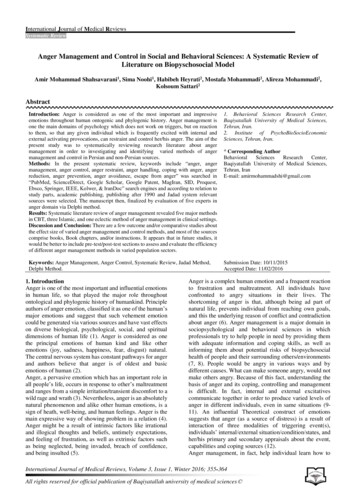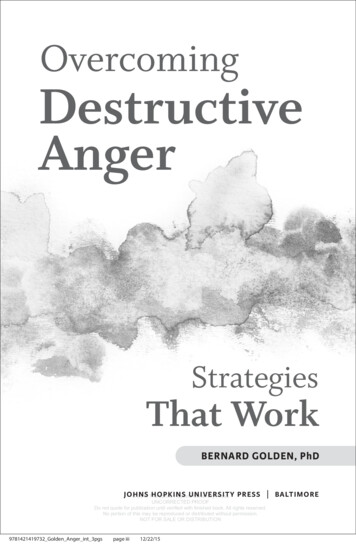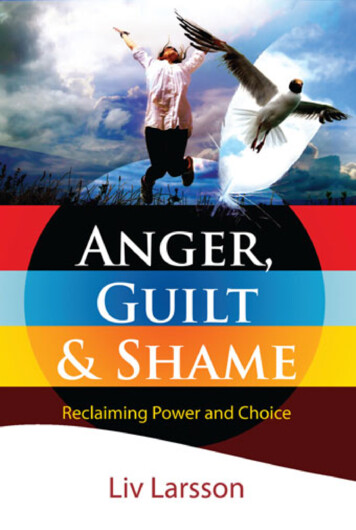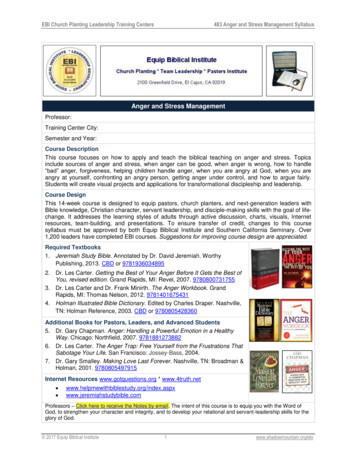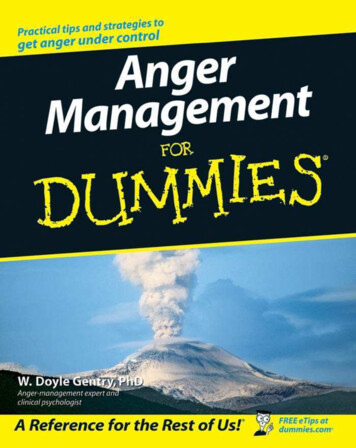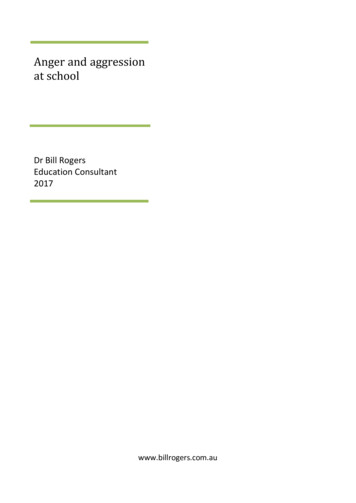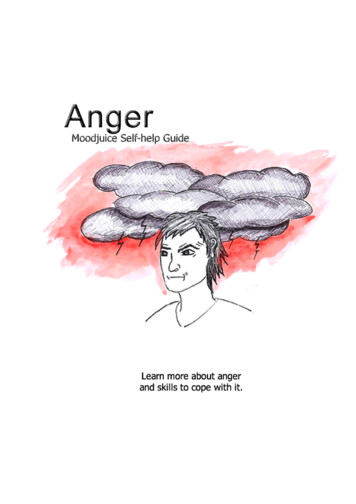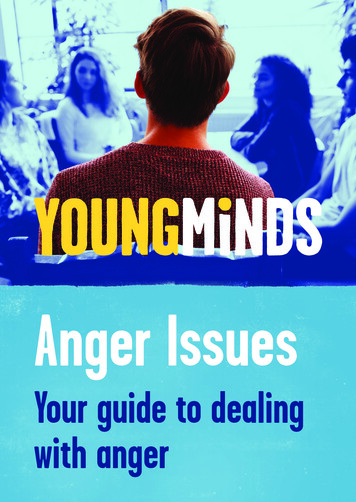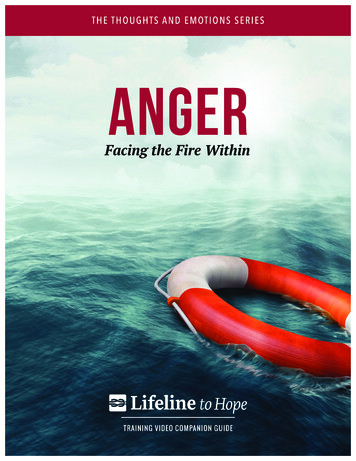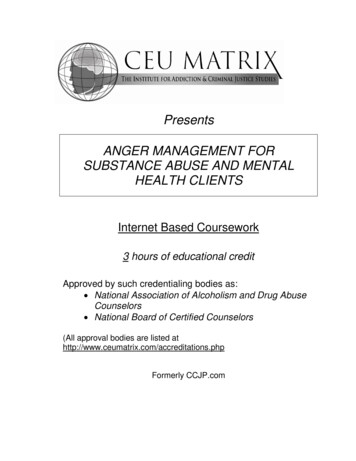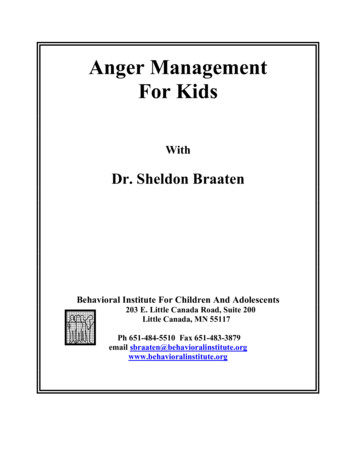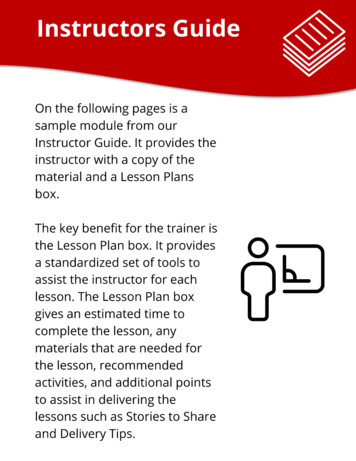
Transcription
Corporate Training Materialwww.corporatetrainingmaterials.com
Accountabilityseparatesthe wishersin life from aysfrustratedaction-takersexpectations.that care enough about their future toexpectations.account for their daily actionsElliot LarsonElliotDiLarsonJohnLemmeSample Module: Understanding AngerBefore we discuss specific anger management strategies, it is helpfulto first understand the nature of anger. While most are familiar withthis emotion, not everyone is aware of its underlying dynamics. Angeris complex and often a misunderstood emotion; it is more than justbeing mad. Anger is a natural response that follows a pattern ofphases, and can transpire from many factors, including other hiddenemotions.The Cycle of AngerAnger is a natural emotion that usually stems from perceived threat or loss. It’s apervasive emotion; it affects our body, thoughts, feelings, and behavior. Anger isoften described in terms of its intensity, frequency, duration, threshold, andexpression.Anger typically follows a predictable pattern: a cycle. Understanding the cycle ofanger can help us understand our own anger reactions, and those of others. It can also help us inconsidering the most appropriate response.Illustrated below are the five phases of the anger cycle: trigger, escalation, crisis, recovery, anddepression. Corporate Training Materialwww.corporatetrainingmaterials.com
aptivePhase1. The Trigger PhaseThe trigger phase happens when we perceive a threat or loss, and our body prepares to respond. Inthis phase, there is a subtle change from an individual’s normal/ adaptive state into his stressedstate. Anger triggers differ from person to person, and can come from both the environment orfrom our thought processes.2. The Escalation PhaseIn the escalation phase, there is the progressive appearance of the anger response. In this phase,our body prepares for a crisis after perceiving the trigger. This preparation is mostly physical, and ismanifested through symptoms like rapid breathing, increased heart rate, and raised blood pressure.Once the escalation phase is reached there is less chance of calming down, as this is the phasewhere the body prepares for fight or flight (to be discussed later).3. The Crisis PhaseAs previously mentioned, the escalation phase is progressive, and it is in the crisis phase that theanger reaction reaches its peak. In the crisis phase our body is on full alert, prepared to take actionin response to the trigger. During this phase, logic and rationality may be limited, if not impairedbecause the anger instinct takes over. In extreme cases, the crisis phase means that a person maybe a serious danger to himself or to other people. Corporate Training Materialwww.corporatetrainingmaterials.com
4. The Recovery PhaseThe recovery phase happens when the anger has been spent, or at least controlled, and there is nowa steady return to a person’s normal/ adaptive state. In this stage, reasoning and awareness of one’sself returns. If the right intervention is applied, the return to normalcy progresses smoothly.However, an inappropriate intervention can reignite the anger and serve as a new trigger.5. The Depression PhaseThe depression phase marks a return to a person’s normal/ adaptive ways. Physically, this stagemarks below normal vital signs, such as heart rate, so that the body can recover equilibrium. Aperson’s full use of his faculties return at this point, and the new awareness helps a person assesswhat just occurred. Consequently, this stage may be marked by embarrassment, guilt, regret, and ordepression.After the depression phase is a return to a normal or adaptive phase. A new trigger, however, can startthe entire cycle all over again. Some people also skip certain phases, or else they go through themprivately and/ or unconsciously.Estimated Time15 minutesTopic ObjectiveTo enumerate and describe the five phases of the anger cycle.Anger is a natural emotion that usually stems from perceived threat orloss.It has five phases: The Trigger Phase. The trigger phase happens when we perceive athreat or loss, and our body prepares to respond. The Escalation Phase. In the escalation phase is the progressiveappearance of the anger response. The Crisis Phase. The crisis phase is when the anger reaction is atits peak. During this phase, logic and rationality may be limited, ifnot impaired. The Recovery Phase. The recovery phase happens when the angerhas been spent, or at least controlled, and there is now a steadyreturn to a person’s normal/ adaptive state. In this stage,reasoning and awareness of one’s self returns. The Depression Phase. The depression phase marks a return to aperson’s normal/ adaptive ways. A person’s full use of his facultiesreturn at this point. Consequently, this stage may be marked byembarrassment, guilt, regret, and or depression.Topic Summary Corporate Training Materialwww.corporatetrainingmaterials.com
Flipchart and MarkersMaterials RequiredWorksheet 1: Cycle of AngerPlanning ChecklistPrepare an example to illustrate the 5 phases of anger, preferably onethat’s suited to the profile of the group. You may also use the example inthis manual.One copy of Worksheet 1: Cycle of Anger per participantHave participants complete Worksheet 1: Cycle of AngerRecommended ActivityIf a participant is comfortable with self-analysis, then he or she can chooseto analyze a personal anger incident for this activity. The incident theythought of for the pre-assignment review can be a subject for the activity.Worksheet One is an optional guide for this activity.Delivery TipsAt this stage of the workshop, the group may not yet be comfortablearound self-reflection and self-disclosure. Succeeding modules, however,have many areas of self-analysis. You may set up for this methodology byexplaining to the group early on that the workshop topic may be sensitiveand personal, but learning can be maximized if concepts are related topersonal experiences.Review QuestionsWhat are the 5 phases of the anger cycle?Is Anger Good or Bad?We all feel angry at one time or another; it is one of our most powerfulemotions. While anger is often believed to be a bad emotion, there is no suchthing as a good or bad emotion. Emotions are intuitive reactions and we donot make conscious decisions for them to come. In fact, some anger reactionsare appropriate and designed to protect you, such as the anger against discrimination, injustice, andabuse.What can be judged as positive or negative/ healthy or unhealthy is how we react to anger. Ourbehavior to express the anger can be constructive, or destructive. If anger is expressed well, it can beused to motivate you to create positive change. Alternatively, anger reactions may also be harmful, suchas anger explosions (losing control over anger, causing rages or violence), or anger repression (bottledup anger that can turn into anxiety and depression). Anger is a normal, healthy emotion. It is not bad tofeel angry, but it is best to share your concerns and resolve anger the right way, before this anger isexpressed negatively. Corporate Training Materialwww.corporatetrainingmaterials.com
Estimated Time10 minutesTopic ObjectiveTo understand what makes anger ‘good’ or ‘bad’.Topic SummaryWhile anger is often believed to be a bad emotion, there is no such thingas a good or bad emotion. Emotions are intuitive reactions and we do notmake conscious decisions for them to come.Materials RequiredFlipchart and markersRecommended ActivityAsk the group for examples of appropriate anger reactions, andinappropriate anger reactions.What are anger explosions?Review QuestionsWhat is anger repression?Fight or FlightThe Fight or Flight theory, formulated by Walter Cannon, describes how people react to perceivedthreat. Basically, when faced with something that can harm us, we either aggress (fight) or withdraw(flight). It is believed that this reaction is an ingrained instinct geared towards survival.The fight or flight instinct is manifested in bodily ways. When faced with a threat, our body releases thehormones adrenaline, noradrenaline, and cortisol. These chemicals are designed to take us to a state ofalertness and action. They result in increased energy, heart rate, slowed digestion, and above normalstrength.Understanding the fight or flight instinct can help us understand the dynamicsof our anger response. The following are some of the implications of the fightand flight theory on anger management:First, the theory underscores how anger is but a natural response. There is nomorality to anger. Anger is a result of perceived harm to self, whether physical or emotional.Second, this theory reminds us of the need to stay in control. When we are angry, our rational self getsoverridden by a basic survival instinct. There’s a need to act immediately. This instinct can then result inaggressiveness, over-reactivity, and hypervigilance, which are all contrary to rational and deliberateresponse. Conscious effort towards self-awareness and control is needed so that this instinct does notoverpower us. Corporate Training Materialwww.corporatetrainingmaterials.com
Estimated Time10 minutesTo understand the fight or flight theory.Topic ObjectiveTopic SummaryTo understand the implications of the fight or flight theory to angermanagement.The Fight or Flight theory describes how people either aggress (fight) orwithdraw (flight) when faced with threats. The fight or flight response isaccompanied by physiological reactions designed for alertness and action.This theory helps to realize that anger is an instinctive reaction, andconscious effort is needed so that it does not overpower us.Materials RequiredFlip chart and markersRecommended ActivityAsk the group for examples of “fight” and “flight” responses during anger.Stories to ShareAnimals also have this instinct. The importance of understanding thissection is to be able to tap into that part of us that would stop us fromacting like animals when faced with anger triggers.Delivery TipsEmphasize the implications of the fight and flight theory in angermanagement.Review QuestionsWhat happens to our bodies when we perceive a threat?Common Myths About AngerHere are four common myths about anger:1. Anger needs to be ‘unleashed’ for it to go away.It’s true that anger needs to be expressed in order for symptoms to be relieved.However, expressing anger in verbally or physically aggressive ways is not the only way to ‘unleash’anger. Nor is anger an excuse for a person to be aggressive. The expression of anger can betempered by rationality and forethought.Note that venting anger does not necessarily result in the anger disappearing, although venting canrelieve the symptoms. At times, processing personal experiences, seeing concrete change andgenuine forgiveness are needed for anger to go away. Corporate Training Materialwww.corporatetrainingmaterials.com
2. Ignoring anger will make it go away.Generally, all kinds of emotions do not disappear when ignored. The anger just gets temporarilyshelved, and will likely find other ways of getting expressed. It can get projected to another person,transformed into a physical symptom, or built up for a bigger future blow up. Some of our behaviorsmay even be unconscious ways of expressing anger.While there are situations when it’s inadvisable to express your anger immediately, the very leastyou can do is acknowledge that it exists.3. You can’t control your anger.This myth is related to the second one. As discussed earlier, the fight and flight instinct can makeanger an overwhelming emotion. However, this instinct does not mean that you’re but a slave toyour impulses. Awareness of anger dynamics and a conscious effort to rise above your anger canhelp you regain control of your reactions.4. If I don’t get angry, people will think I am a pushover.It’s true that a person can lose credibility if they make rules and then ignores violations. However,anger is not the only way a person can show that there are consequences to violations. In fact, themost effective way of instilling discipline in others is to have a calm, non-emotional approach todealing with rule-breakers. Calm and rationality can communicate strength too.Estimated Time10 minutesTopic ObjectiveTo list common misconceptions about anger and their refutations.Common myths about anger includes:1. Anger needs to be ‘unleashed’ for it to go away.Topic Summary2. Ignoring anger will make it go away.3. You can’t control your anger.4. If I don’t get angry, people will think I’m a pushover.Materials RequiredFlip chart and markersPresent each of the myths to the class in the form of a debatable question.Example: “Can you control your anger?”Recommended ActivitySolicit opinions and encourage a friendly group debate before providing thefactual refutation of the myth.Delivery Tips Corporate Training MaterialYou may also solicit from the group other anger myths that they know.www.corporatetrainingmaterials.com
Sources of AngerThe root cause of many anger responses come from underlying emotions within. Anger isa normal response that is often experienced as a secondary emotion. This concept can berepresented with the Anger Iceberg. The Anger Iceberg illustrates the idea that emotionalreactions are not always one-dimensional, rather there are many hidden causes.Although anger may be presented and expressed on the outside, there are otherunderlying emotions that give energy to this anger.Emotions that frequently prompt anger include: Frustration- “Frustration begets anger, and anger begets aggression”. When a goal is blockedfrom reaching the desired result, individuals will become frustrated. This frustration will provokeanger as an emotional response, directed at the object recognized as the cause of thefrustration. Hurt/Loss- In this case, anger is used as a substitute emotion. Individuals will turn to anger, as asubstitute to feeling pain. Anger is a normal stage during a grieving process. This can be doneconsciously, or unconsciously. Disrespected- Feelings of being disrespected is one of the most common emotions that fuelanger. This occurs when individuals are not given the respect that they deserve, or that they arealways under attack. Fear- People will choose anger as a defense mechanism against fear. Fear and anger derive fromfeelings of control; while fear will typically arise from a loss of control, anger is a means ofgaining back control. Corporate Training Materialwww.corporatetrainingmaterials.com
Shame- Anger is used as a defense response when individuals perceive they are beinghumiliated, criticized, or rejected. Anger is a way to distract us from feelings of shame. Guilt- Feelings of anger will frequently follow guilt. Reacting with anger is used as a way toprotect our ego, and remove ourselves from the blame. Unfortunately, this means that blame istaken from within and placed on another individual. Sadness- When we feel sad, we feel vulnerable and as though we have loss of control. To avoidthese feelings of sadness, we will subconsciously shift into an anger mode to mask feelings ofdisappointment or discouragement.Estimated Time15 minutesTopic ObjectiveTo understand that anger often comes from underlying emotions, and howthe ‘Anger Iceberg’ can represent this concept.Anger is a normal response that is often experienced as a secondaryemotion. The Anger Iceberg illustrates the idea that emotional reactionsare not always one-dimensional, rather there are many hidden causes.Emotions that frequently prompt anger include:Topic Summary essFlipchart and markersMaterials RequiredWorksheet 2: The Anger IcebergPlanning ChecklistOne copy of Worksheet 2: The Anger Iceberg per participantHave participants complete Worksheet 2: The Anger Iceberg.Recommended ActivityDiscuss and review responses as a group.Delivery TipsYou can also draw the Anger Iceberg on flip chart paper instead of usingthe worksheet.Review QuestionsWhat is a secondary emotion? Corporate Training Materialwww.corporatetrainingmaterials.com
Practical IllustrationJosephine came home from work to see dirty plates left in the sink (trigger phase). Shestarted to wash them, but as she was doing so, she kept thinking about how inconsiderateher children are for not cleaning after themselves. She was already tired from work and didnot need the extra chore. She felt the heat in her neck and the tremble in her hands as shewas washing the dishes (escalation phase).Feeling like she couldn’t keep it to herself any longer, she stormed upstairs to confront her kids. In araised voice, she asked them how difficult it was to wash the dishes. She told them that they are gettingpunished for their lack of responsibility (crisis phase).Having gotten the words out, she felt calmer, and her heartbeat slowly returned to normal. She saw thather kids were busy with homework when she had interrupted them. She was also better able to heartheir reasoning, as they apologized (recovery phase).Josephine regretted yelling at her children and told them that she was simply just tired and that it wasnot their fault (depression phase). Corporate Training Materialwww.corporatetrainingmaterials.com
Module Two: Review Questions1. Which of the following is not one of the five phases of nDiscovery is not one of the five phases of anger.2. Once a person returns to a normal or adaptive phase, a new trigger cannot start the entire cycleall over again.a) Trueb) FalseFalse- A new trigger can start the entire cycle over again.3. Anger is always considered a bad emotion.a) Trueb) FalseWhile anger is often believed to be a bad emotion, there is no such thing as a good or bad emotion.4. What is anger repression?a)b)c)d)Losing control over anger, causing rage or violenceBottling up angerExpressing your anger in an effective mannerNot having any feelings of angerAnger repression is bottled up anger, that can turn into anxiety or depression.5. or describes how people react to a perceived threat.a)b)c)d)Win or loseRun or hideSmile or frownFight or flightFight or flight describes how people react to a perceived threat. Corporate Training Materialwww.corporatetrainingmaterials.com
6. Anger is a result of perceived harm to self, whether physical or .a)b)c)d)RealEmotionalNegotiatedEscalatedAnger is a result of perceived harm to self, whether physical or emotional.7. Which is not a common myth about anger?a)b)c)d)Anger needs to be ‘unleashed’ for it to go awayIgnoring anger will make it go awayYou can’t control your angerYou can control your angerA common myth about anger is that it cannot be controlled.8. Anger is never an appropriate reaction?a) Trueb) FalseFalse- There are times when anger is an appropriate reaction.9. What does it mean for anger to be a secondary emotion?a)b)c)d)It is not an important emotionAnger responses will often come from other underlying emotionsIt takes another individual to cause angerNone of the aboveThe root cause of many anger responses come from underlying emotions within.10. Which of the following is an emotion that will frequently prompt on is an emotion that will frequently prompt anger. Corporate Training Materialwww.corporatetrainingmaterials.com
Corporate Training Materialwww.corporatetrainingmaterials.com
Corporate Training Materialwww.corporatetrainingmaterials.com
Corporate Training Materialwww.corporatetrainingmaterials.com
Corporate Training Materialwww.corporatetrainingmaterials.com
Corporate Training Materialwww.corporatetrainingmaterials.com
Corporate Training Materialwww.corporatetrainingmaterials.com
Corporate Training Materialwww.corporatetrainingmaterials.com
Corporate Training Materialwww.corporatetrainingmaterials.com
Corporate Training Materialwww.corporatetrainingmaterials.com
Worksheet 1Cycle of AngerThink of a person whose anger reaction you have observed. It can be a family member, a friend, oranyone you observed being angry.Recall the anger reaction. Now think of the phases of the anger cycle. Interpret the anger reaction thatwas observed, using the anger cycle.In the spaces below, write at least one behavioral indicator of anger manifested by this person for eachphase of the anger cycle.Anger CyclePhaseBehavioral IndicatorsThe Trigger PhaseThe EscalationPhaseThe Crisis PhaseThe RecoveryPhaseThe DepressionPhase Corporate Training Materialwww.corporatetrainingmaterials.com
Worksheet 2The Anger IcebergComplete the Anger Iceberg below with emotions that may prompt anger. Think of emotions that werenot previously discussed. Corporate Training Materialwww.corporatetrainingmaterials.com
Icebreaker: Team TrinketsPURPOSEConflict resolution can be a difficult topic, so it is important that participants are as comfortable aspossible. This activity will help participants get to know each other while doing a non-conflict laden task.MATERIALS REQUIRED Paper plates String Single hole punch Flip chart or banner paper Legal-sized paper (or blank name tents) Colored markers Craft supplies (scissors, glue, sparkles, yarn, etc.)ACTIVITYAsk participants to number off to create groups of six to eight. Their task is to come up with a teamname and slogan, preferably based on something that they all have in common. They should then createtwo of the following items:1. Name cards for each participant2. Team sign3. Team hats4. Team work area5. Team songGive participants about ten minutes for this task.PRESENTATIONSAfter all groups have completed the task, ask each group to present their team name, slogan, and items,and to explain how they arrived at a decision for each. Ask participants if conflicts arose over choices,and how those conflicts were managed.Encourage groups to work together throughout the day and strengthen their bond. Corporate Training Materialwww.corporatetrainingmaterials.com
Corporate Training Materialwww.corporatetrainingmaterials.com
CERTIFICATE OF COMPLETION[Name]Has mastered the courseAnger ManagementAwarded this day of , 20Presenter Name and Titlewww.corporatetrainingmaterials.com Corporate Training Material
Anger typically follows a predictable pattern: a cycle. Understanding the cycle of anger can help us understand our own anger reactions, and those of others. It can also help us in considering the most appropriate response. Illustrated below are the five phases of the anger cycl
